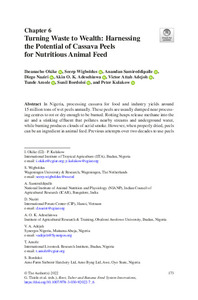| dc.contributor.author | Okike, I. |
| dc.contributor.author | Wigboldus, S. |
| dc.contributor.author | Samireddypalle, A. |
| dc.contributor.author | Naziri, D. |
| dc.contributor.author | Adesehinwa, A.O.K. |
| dc.contributor.author | Adejoh, V.A. |
| dc.contributor.author | Amole, T. |
| dc.contributor.author | Bordoloi, S. |
| dc.contributor.author | Kulakow, P. |
| dc.date.accessioned | 2022-10-13T08:56:14Z |
| dc.date.available | 2022-10-13T08:56:14Z |
| dc.date.issued | 2022 |
| dc.identifier.citation | Okike, I., Wigboldus, S., Samireddipalle, A., Naziri, D., Adesehinwa, A.O.K., Adejoh, A.V., ... & Kulakow, P. (2022). Turning waste to wealth: Harnessing the potential of cassava peels for nutritious animal feed. IN: Thiele, G., Friedmann, M., Campos, H., Polar, V. and Bentley, J.W. (eds.). (2022). Root, tuber and banana food system innovations. Cham, Switzerland: Springer, (p.173–206). |
| dc.identifier.isbn | 978-3-030-92021-0 |
| dc.identifier.uri | https://hdl.handle.net/20.500.12478/7868 |
| dc.description.abstract | In Nigeria, processing cassava for food and industry yields around 15 million tons of wet peels annually. These peels are usually dumped near processing centres to rot or dry enough to be burned. Rotting heaps release methane into the
air and a stinking effluent that pollutes nearby streams and underground water, while burning produces clouds of acrid smoke. However, when properly dried, peels can be an ingredient in animal feed. Previous attempts over two decades to use peels in animal feed failed to yield profitable options for drying wet peels at commercial scale, but recent research suggests that cassava peels can be processed into high-quality cassava peel (HQCP) products to be used as nutritious, low-cost animal feed ingredients. The core innovation was to adopt the same steps and equipment used for processing cassava roots into gari, the main staple food in the country. When dried, 3 tons of wet peels yield a tonne of healthy and energy-rich animal feed, containing nearly 3,000 kilocalories per kilogram of dry matter (kcal/kgDM). Adopting this innovation at scale in Nigeria’s poultry and fish sectors alone has the potential to turn approximately 3.6 million tons of wet peels into 1.2 million tons of feed ingredients capable of replacing approximately 810,000 tons of largely imported
maize. The innovation has great potential to increase feed availability and lower its cost while saving cereals for human consumption, reducing the import bill, creating new business opportunities, and protecting the environment. This research was initiated by CGIAR centres and taken up by the CGIAR Research Program on Roots, Tubers and Bananas (RTB) over the past decade with strategic input from the CGIAR Research Program on Livestock to accelerate development of the innovation, and this chapter documents the potential and progress in taking this innovation to scale. |
| dc.description.sponsorship | CGIAR Research Program on Roots, Tubers and Bananas |
| dc.description.sponsorship | CGIAR Research Program on Livestock |
| dc.description.sponsorship | CGIAR Trust Fund |
| dc.description.sponsorship | International Livestock Research Institute |
| dc.description.sponsorship | CGIAR Systemwide Livestock Programme |
| dc.format.extent | 173-206 |
| dc.language.iso | en |
| dc.publisher | Springer |
| dc.subject | Cassava |
| dc.subject | Animal Feeding |
| dc.subject | Feeds |
| dc.subject | Small And Medium Enterprises |
| dc.title | Turning waste to wealth: harnessing the potential of cassava peels for nutritious animal feed |
| dc.type | Book Chapter |
| cg.contributor.crp | Roots, Tubers and Bananas |
| cg.contributor.affiliation | International Institute of Tropical Agriculture |
| cg.contributor.affiliation | Wageningen University and Research Centre |
| cg.contributor.affiliation | Indian Council of Agricultural Research |
| cg.contributor.affiliation | International Potato Center |
| cg.contributor.affiliation | Obafemi Awolowo University |
| cg.contributor.affiliation | Synergos Nigeria, Nigeria |
| cg.contributor.affiliation | International Livestock Research Institute |
| cg.contributor.affiliation | Amo Farm Sieberer Hatchery Ltd, Nigeria |
| cg.coverage.region | Africa |
| cg.coverage.region | West Africa |
| cg.coverage.country | Nigeria |
| cg.coverage.hub | Headquarters and Western Africa Hub |
| cg.researchtheme | Biotech and Plant Breeding |
| cg.identifier.bibtexciteid | OKIKE:2022 |
| cg.authorship.types | CGIAR and developing country institute |
| cg.iitasubject | Cassava |
| cg.iitasubject | Post-Harvesting Technology |
| cg.iitasubject | Value Chains |
| cg.publicationplace | Cham, Switzerland |
| cg.accessibilitystatus | Open Access |
| cg.reviewstatus | Peer Review |
| cg.usagerightslicense | Creative Commons Attribution 4.0 (CC BY 0.0) |
| cg.targetaudience | Scientists |
| cg.identifier.doi | http://dx.doi.org/10.1007/978-3-030-92022-7_6 |
| cg.iitaauthor.identifier | Iheanacho Okike: 0000-0001-7059-8595 |
| cg.iitaauthor.identifier | Peter Kulakow: 0000-0002-7574-2645 |
| cg.futureupdate.required | No |

